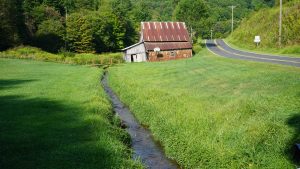 A recent New York Times article titled “They Fought the Lawn and the Lawn’s Done” looked at the ‘growing problem’ of conflict between homeowner’s associations and homeowners who want to rewild their backyard by planting wild grasses and wild-flowers. In one camp, there are environmental advocates committed to reintroducing native plants and facilitating local pollinators, and in the other camp, homeowner’s associations and neighbors who want to maintain a traditional lawn free of wild plants
A recent New York Times article titled “They Fought the Lawn and the Lawn’s Done” looked at the ‘growing problem’ of conflict between homeowner’s associations and homeowners who want to rewild their backyard by planting wild grasses and wild-flowers. In one camp, there are environmental advocates committed to reintroducing native plants and facilitating local pollinators, and in the other camp, homeowner’s associations and neighbors who want to maintain a traditional lawn free of wild plants
Backyard Rewilding: What is At Stake
There’s a lot more at stake than aesthetics in these conflicts. Some of the issues may include:
- The cost of lawns — With hotter summers, maintaining a traditional lawn could be expensive for a homeowners association and homeowners may disagree on whether to keep their traditional lawn.
- Allergies — Some wild grasses and seeds could cause allergic reactions in neighbors with asthma and other conditions.
- Protecting local species in the area — Backyard rewilding can be of huge benefit to local, struggling pollinators and other species. To have an impact, backyards should be planted with local plants and flowers.
- Boundary disputes – Some boundaries between neighbors are not entirely clear, or a neighbor’s garden abuts onto another property without a physical barrier like a fence. In these cases, wild plants could migrate to another yard or be planted in an area that is legally in dispute.
- Invasive species – Not all wild plants are beneficial to the local area. Without management, rewilding a backyard could introduce invasive species like Japanese Knotweed that might affect building structures and overrun local flora.
- Property values – The appearance of wild gardens may affect property values in groups of houses or apartments managed by a home-owners association.
Why Did Backyard Rewilding Make the News?
 The National Wildlife Federation reported a 50 percent increase in people creating wildlife gardens certified by the organization in 2020. During the pandemic, more people turned to eco-conscious gardening, planting wild-flower meadows or letting traditional gardens go fallow. Backyard rewilding made the news after the state of Maryland passed the first law in the country limiting homeowner associations’ control over eco-friendly yards. The law emerged out of a dispute between neighbors which escalated into a lawsuit. The couple at the center of the lawsuit spent $60,000 in attorney fees defending their eco-friendly back-yard from destruction.
The National Wildlife Federation reported a 50 percent increase in people creating wildlife gardens certified by the organization in 2020. During the pandemic, more people turned to eco-conscious gardening, planting wild-flower meadows or letting traditional gardens go fallow. Backyard rewilding made the news after the state of Maryland passed the first law in the country limiting homeowner associations’ control over eco-friendly yards. The law emerged out of a dispute between neighbors which escalated into a lawsuit. The couple at the center of the lawsuit spent $60,000 in attorney fees defending their eco-friendly back-yard from destruction.
How Does Land Mediation Resolve Rewilding Disputes?
Not everyone involved in a backyard dispute with neighbors or a homeowner’s association has the funds to pay out $60,000 to fight their neighbors in court and get the law changed. As people become more environmentally conscious, private backyards are more likely to become a battleground between lawn traditionalists and eco-conscious homeowners. Most land in the US is privately owned, so these conflicts are literally fought in people’s backyards .
With the rise of eco-conscious gardening, people will have to find a way to compromise. Advocacy and cooperation are better ways for most individuals to achieve environmentally friendly goals then fighting it out in court.
Land rights mediation and environmental mediation helps you negotiate with your neighbors for a fraction of the cost of litigation.  You can work out a compromise with your neighbors, such as creating barriers between wild plants and traditional plantings, screening off wild plantings with more attractive trees and shrubs, and cooperating on water conservation. Land rights mediation, water mediation, environmental mediation and any mediation related to climate change and ecosystems involves thorough research, which leads to community education and enhancement. Local environmental groups can certify a backyard, so that neighbors can be assured the project is being undertaken responsibly and doesn’t attract invasive plant species or wildlife. Wild backyards may also increase the health of nearby traditional plantings by attracting pollinators. Community members, advocacy groups and interested parties such as property owners can sit down and discuss their values to work out a fair and respectful agreement. In doing so, they may learn more about the local environment and each other, which can build lasting cooperation.
You can work out a compromise with your neighbors, such as creating barriers between wild plants and traditional plantings, screening off wild plantings with more attractive trees and shrubs, and cooperating on water conservation. Land rights mediation, water mediation, environmental mediation and any mediation related to climate change and ecosystems involves thorough research, which leads to community education and enhancement. Local environmental groups can certify a backyard, so that neighbors can be assured the project is being undertaken responsibly and doesn’t attract invasive plant species or wildlife. Wild backyards may also increase the health of nearby traditional plantings by attracting pollinators. Community members, advocacy groups and interested parties such as property owners can sit down and discuss their values to work out a fair and respectful agreement. In doing so, they may learn more about the local environment and each other, which can build lasting cooperation.
At Boileau Conflict Solutions, we offer land mediation, climate change mediation, water mediation, animal rights mediation and a variety of ecosystem focused mediation. Our mediators understand that environmentally conscious projects should be undertaken in an informed and responsible manner. Our mediations are grounded by legal expertise, thorough research into environmental science, financial expertise and understanding of the math of conflict resolution. We can clearly show, using tried and tested mathematical models, the ways in which conflict fails everyone economically and environmentally. We have offices in Bozemann Mt, Michigan, San Diego, Berkeley and Silicon Valley, CA and can mediate in person or remotely. Please contact us to learn more about how we can assist you with your backyard dispute or homeowner’s dispute.
